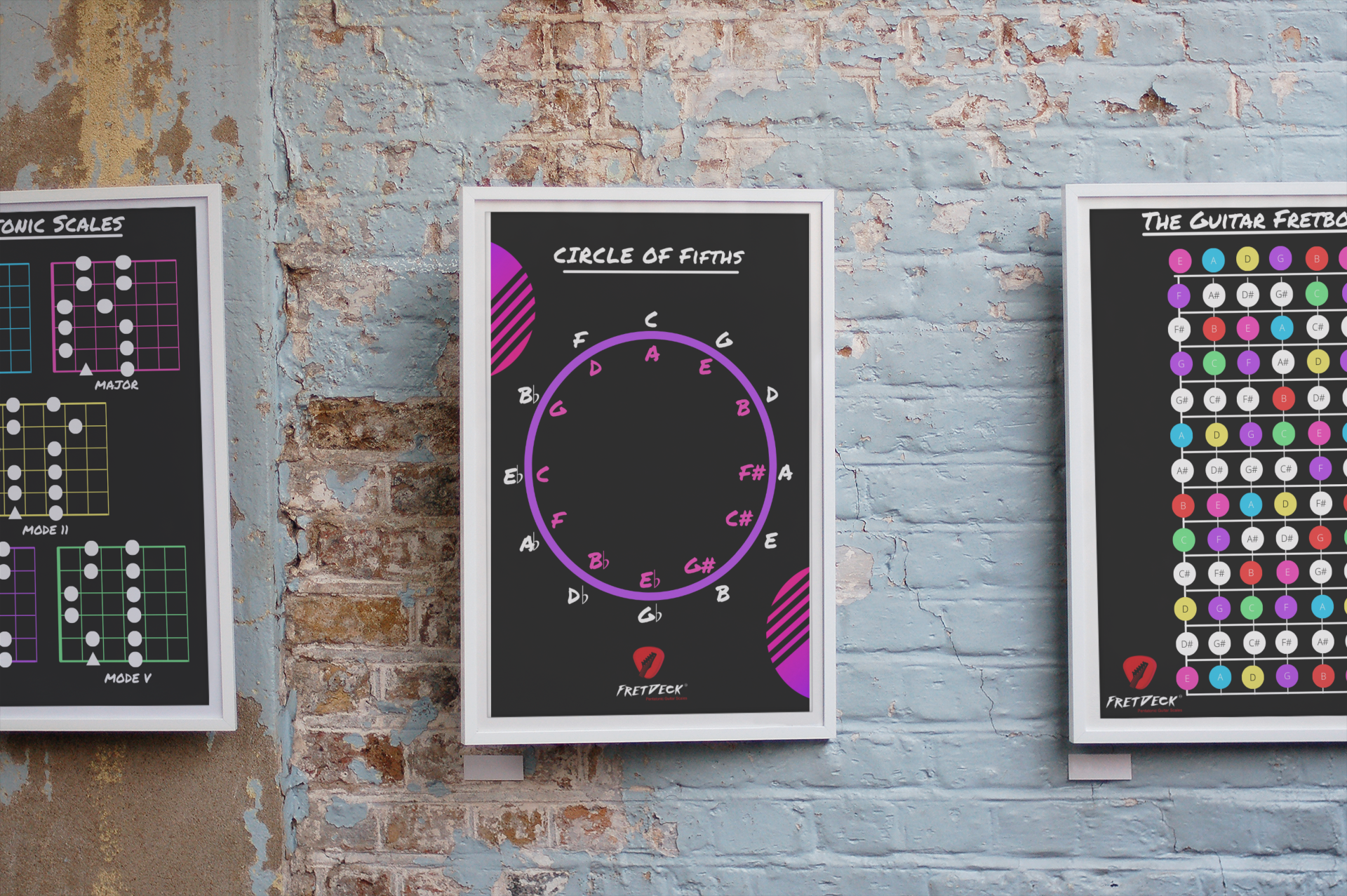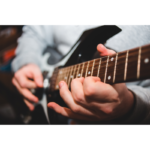“You don’t need to practice for hours. You just need to practice the right things, every day.”
Starting your journey on guitar? You’ve already made the most important decision—picking it up. Now, here’s the secret to real progress: You need a guitar practice routine that actually works.
One that’s clear.
One that’s focused.
One that helps you play music—not just exercises.
In this post, you’ll get a full breakdown of the ideal beginner guitar practice routine—with simple habits, a flexible schedule, and powerful exercises to help you grow fast (and have fun while doing it).
🎯 Why You Need a Guitar Practice Routine
Most beginners struggle not because they lack motivation—but because they lack a system.
A great routine helps you:
- ✅ Build consistency
- ✅ Improve faster with less frustration
- ✅ Stay motivated by tracking real progress
🎸 Want a deck of practice prompts + scales + chord guides?
Back the FretDeck™ Kickstarter
You’ll get a full beginner course and access to our Discord for daily support.

❌ Stop Guessing. Start Shredding.
If you’re still fumbling through scale patterns and box shapes… it’s costing you progress.
FretDeck™ is the no-fluff system that shows you exactly how to master the fretboard—fast. Early access.
⚡️ This isn’t for dabblers. It’s for players who want results.
👉 Click here to join the pre-launch now
Early access. Limited rewards. Don’t wait.
🔧 Step 1: Set Up Your Practice Environment
Before you play a single note, get your space in order.
- Comfortable Chair: Your posture affects your playing.
- Good Lighting: You need to see your frets clearly.
- Zero Distractions: Turn off your phone. This is your moment.
Also, set a practice time that works for you—ideally the same time each day. Habit loves rhythm.
🧱 Step 2: The 7-Part Beginner Guitar Practice Routine
Here’s a proven daily routine that covers everything you need to improve:
1. Warm-Up (5–10 Minutes)
- Finger stretches
- Chromatic runs (1-2-3-4 up and down each string)
- String skipping for coordination
Start slow. Focus on accuracy over speed.
2. Chord Practice (15 Minutes)
- Review open chords (G, C, D, A, E, Am, Em, Dm)
- Practice transitions: G to C, A to E, etc.
- Strumming patterns: Start with simple downstrokes, then add ups and syncopation
🎯 Need help remembering your chords?
Use the free guitar chord charts or unlock all 27 charts when you back FretDeck™.
3. Scales & Finger Exercises (15 Minutes)
- Minor Pentatonic Scale (start in A)
- Major Scale (G position is ideal for beginners)
- Practice 2- and 3-note-per-string patterns for finger dexterity
Use a metronome. Play slowly. Breathe between patterns.
🔥 The FretDeck™ Kickstarter gives you 60 pentatonic scale patterns in every key—visualized and playable.
Grab yours here.
4. Learn a Song (20–30 Minutes)
- Pick one simple song
- Break it down by section (intro, verse, chorus)
- Loop small sections
- Play along with a recording once you’re confident
Songs bring joy. They glue together everything you’ve practiced.
🎶 Use familiar songs like “Knockin’ on Heaven’s Door,” “Wish You Were Here,” or “Horse With No Name.”
5. Technique Builder (15 Minutes)
- Alternate picking
- Hammer-ons and pull-offs
- Slides and bends
- Use riffs to make it musical
These are your tools for soloing and expression. Add one new technique each week.
6. Theory & Ear Training (10–15 Minutes)
- Identify intervals by ear (start with major 3rd and perfect 5th)
- Recognize chords (play one, guess it with your eyes closed)
- Learn the Circle of Fifths
Even 5 minutes a day here adds up to serious musicianship over time.
7. Improvisation & Creativity (10–15 Minutes)
- Use jam tracks
- Create your own licks with the A minor pentatonic
- Write a 3-chord progression and solo over it
Play without judgment. Just have fun.
🎸 Share your progress in our Discord group, Guitar Freaks Hangout.
Join free here and meet other guitarists practicing alongside you.
🗓️ Sample Weekly Practice Schedule
| Day | Focus |
|---|---|
| Monday | Warm-up, chords, learn a new song |
| Tuesday | Scales, finger drills, jam track improvisation |
| Wednesday | Chords, song review, hammer-ons + slides |
| Thursday | Scale practice, music theory, play along with song |
| Friday | Technical work, improv, create a short riff |
| Saturday | Long session: combine everything, review week’s work |
| Sunday | Light session: listen to guitar music, organize your next week |
💡 7 Tips for Building the Habit
- Start small – Even 20 focused minutes is enough
- Set goals – “Today I’ll learn G to C transitions”
- Track progress – Use a notebook or digital journal
- Celebrate wins – Learned your first full song? That’s HUGE
- Join a community – Accountability changes everything
- Mix things up – Add a new technique or song weekly
- Play something fun – Always end your session with joy
🎯 Need help staying motivated?
Our Guitar Freaks Discord gives you prompts, challenges, and encouragement.
Join here – it’s free, and it’s fun.

🎸 Join the Guitar Freaks Patreon!
Get SoloCraft E-Book FREE!
When you join Guitar Freaks on Patreon, you’ll instantly unlock my full e-book SoloCraft—your complete guide to fretboard mastery and building unforgettable solos. Think of it as your shortcut to playing with confidence and creativity.
👉 Don’t miss out—join now and grab your free copy!
📌 Bonus: Print This Routine
Want to keep this visible in your practice space?
Download the FretDeck Beginner Practice Card when you back our Kickstarter.
It includes:
- Daily checklist
- Chord & scale prompts
- Links to practice tracks and videos
👉 Back FretDeck™ now on Kickstarter and get all bonuses, courses, and Discord access.
🎸 Final Thoughts: Don’t Practice More. Practice Smarter.
You don’t need to play for 2 hours a day. You need a routine that works.
With this beginner guitar practice routine, you’ll build:
- Muscle memory
- Musical confidence
- Real momentum
Stay consistent. Stay curious. And most importantly—keep playing.
Check out our complete guide to simple guitar chord charts for beginners to get easy chord diagrams and transition tips.
🎯 Your Next Steps:
✅ Back FretDeck™ on Kickstarter
✅ Join the Guitar Freaks Hangout Discord
✅ Explore Free Guitar Charts

Download FREE Guitar Charts!
We have 27 FREE guitar charts to help you learn the guitar fretboard. Learn How to play chords and scales with these free resources.
Free Guitar Resources










